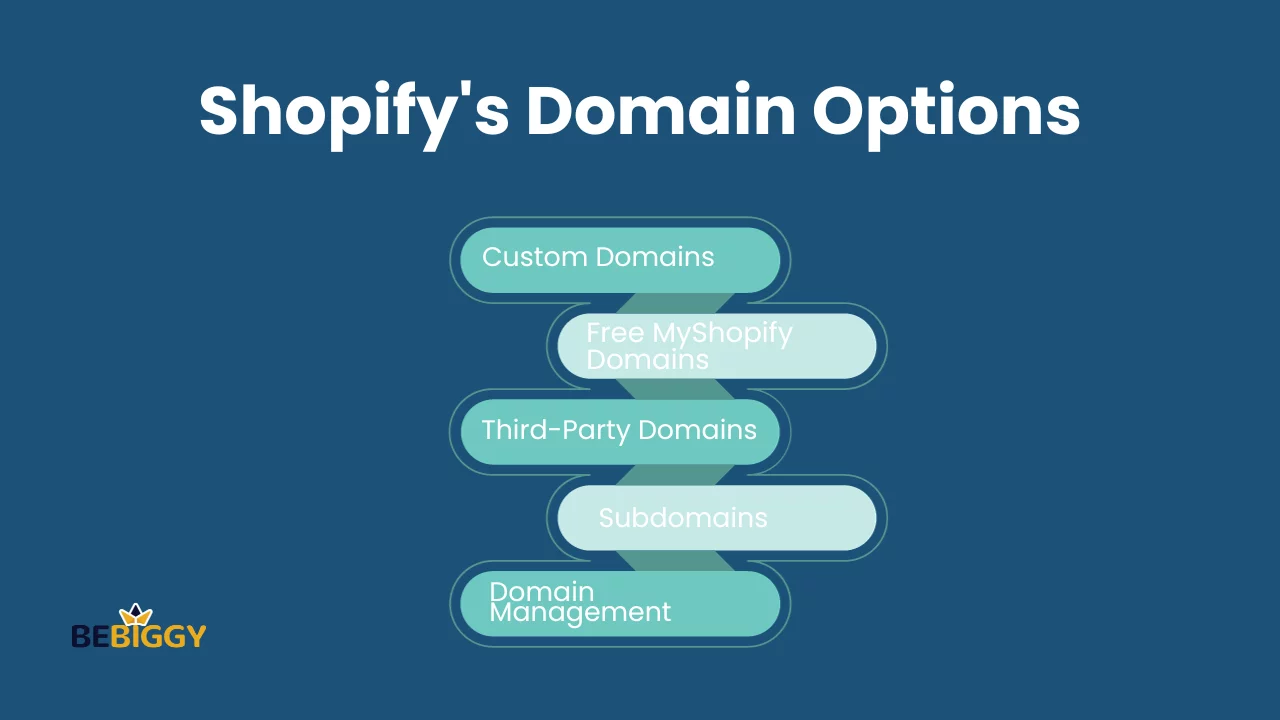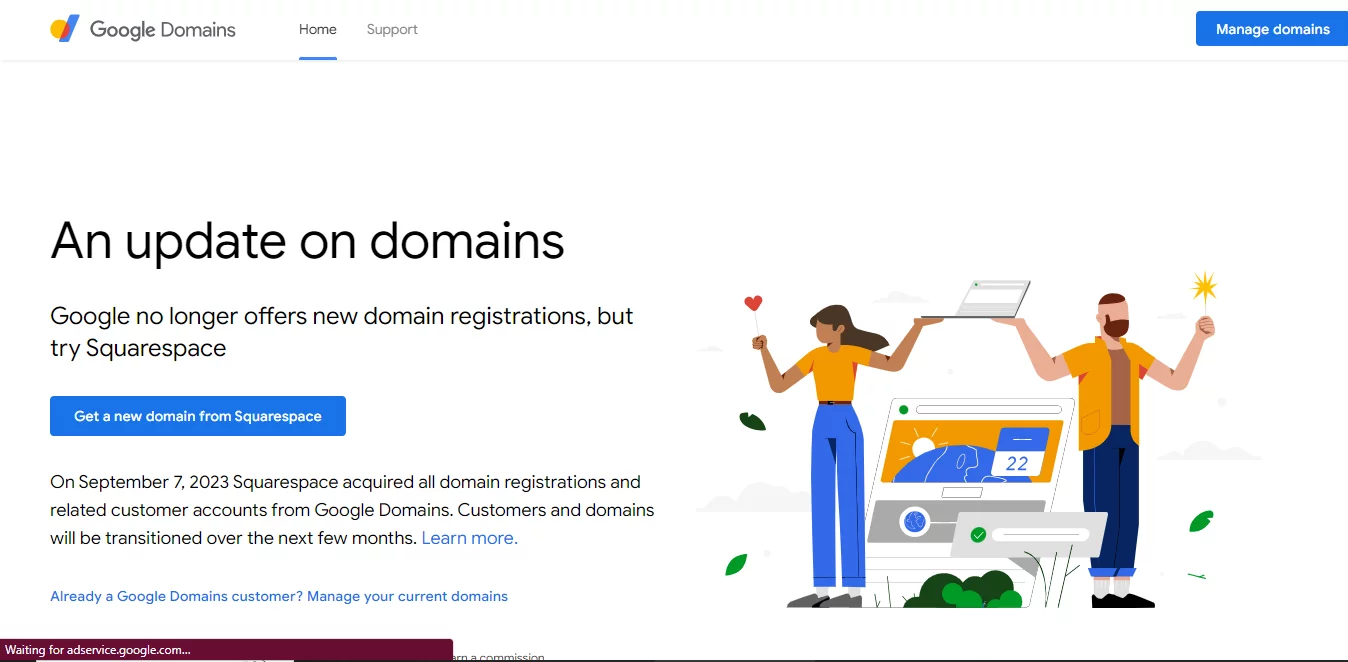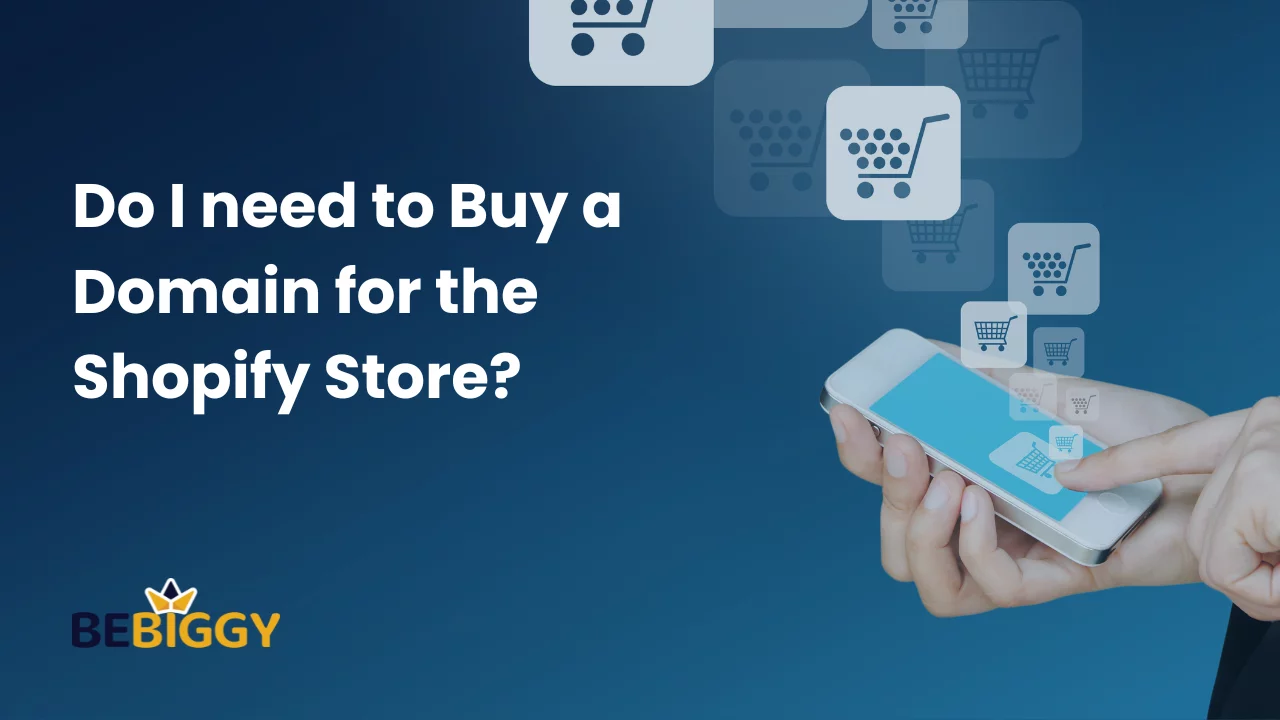Starting an online business through Shopify is an enticing venture, but it often raises questions about domains. Do I need to buy a domain for Shopify store, or can I operate without one?
This article delves into the significance of domain names for your e-commerce journey. It explores why a domain might be essential for your brand, what options Shopify provides, and the benefits of securing a unique web address.
If you’re wondering whether a domain is necessary for your Shopify store, read on to discover the answers you need.
What is Shopify Domain?

A Shopify domain is the web address where your customers go to find your Shopify store online. It’s the address that you type into your web browser to visit your store.
You’re given a free Shopify domain when you first start a Shopify store. This domain is functional but looks less professional than a custom domain.
You purchase a custom domain from a domain registrar like GoDaddy or Namecheap. It’s a domain unique to your business and matches your brand.
In order for clients to access your store using your custom domain name, you may connect your Shopify store to your custom domain.This is a good idea because it makes your store look more professional and trustworthy.
Shopify’s Domain Options

Shopify offers a variety of domain options to help businesses establish a strong online presence. Here’s a breakdown of these domain options:
- Custom Domains: Users can connect their existing domain or purchase a new one directly through Shopify. This allows for a branded web address, such as “www.yourstorename.com.”
- Free MyShopify Domains: Shopify provides a free domain for users who don’t have their own. These domains typically include “.myshopify.com” and are a good starting point for new businesses.
- Third-Party Domains: Users can link their Shopify store to domains purchased from third-party registrars like GoDaddy or Namecheap. This provides flexibility in choosing domain providers.
- Subdomains: Subdomains, like “shop.yourstorename.com,” can be set up to organize and direct traffic to specific website sections.
- Domain Management: Shopify offers domain management features that make it easy to configure DNS settings, set up email forwarding, and ensure domain security.
Here are a few examples of Shopify’s domains:
- myshopify.com
- myshopcom
- myshopifystore.com
- myshopify.ca
- myshopca
- myshopifystore.ca
- myshopify.co.uk
- myshopco.uk
- myshopifystore.co.uk
- myshopify.de
- myshopde
- myshopifystore.de
- myshopify.fr
- myshopfr
- myshopifystore.fr
- myshopify.jp
- myshop.jp
- myshopifystore.jp
- myshopify.com.au
- myshopcom.au
- myshopifystore.com.au
Pros and Cons

Pros
- Integration and Convenience: Buying a domain from Shopify offers seamless integration with your Shopify store. This simplifies the setup and management of your online presence.
- Simplified Setup: Shopify streamlines the domain setup process, making it beginner-friendly. You won’t need to navigate third-party domain registrars.
- Automatic Renewals: Shopify often includes automatic domain renewals with their domains, reducing the risk of accidentally losing your web address.
- Technical Support: When you purchase a domain from Shopify, you gain access to their customer support for domain-related issues.
- DNS Management: Shopify provides a user-friendly dashboard for DNS management, which is especially helpful for users with minimal technical expertise.
- Automatic SSL certificate: When you buy a domain name from Shopify, an SSL certificate is automatically generated. This helps to protect your website and your customer’s data.
- Email forwarding: Shopify allows you to set up email forwarding for your domain name. This means you can receive emails sent to your domain name in your email inbox.
- Domain locking: Shopify offers domain locking, which prevents unauthorized changes to your domain settings. This helps to protect your domain from being hacked or stolen.
- Domain privacy: Shopify offers domain privacy protection, which hides your personal information from whois lookups. This helps to protect your privacy and avoid spam.
- Domain management: Shopify provides a comprehensive suite of domain management tools, which makes it easy to manage your domain settings, DNS records, and email forwarding.
Cons
- Pricing: Shopify’s domain pricing can be slightly higher than some third-party registrars. This could lead to increased long-term costs.
- Limited Domain Extensions: The selection of domain extensions (TLDs) available through Shopify might be more limited compared to other registrars, which could limit your choices.
- Transferring Complexity: If you decide to move your domain away from Shopify in the future, the process might be less straightforward compared to domains registered with independent registrars.
- No Multilingual Domains: Shopify does not support all international domain extensions, potentially limiting your options if you have a global customer base.
How to Buy and Set Up a Shopify Domain
To buy and set up a Shopify domain, follow these steps:
Step 1: Go to your Shopify admin panel.
Step 2: Click on Settings > Domains.
Step 3: Click on Buy a new domain.
Step 4: Enter the desired domain name buy and click Search.
Step 5: Select the domain name you want to buy and click Add to Cart.
Step 6: Review your purchase and click on Complete purchase.
Step 7: To pay now, enter your billing information and click.
Once you have purchased your domain name, it will be added to your Shopify store. You must connect your domain name to your Shopify store before you can use it.
Connecting Domain Name With Shopify Store
Your Shopify store’s domain name can be linked to it by follow these steps:
Step 1: Go to your Shopify admin panel.
Step 2: Click on Settings > Domains.
Step 3: By clicking on it, choose the domain name to which you want to link.
Step 4: Under Domain settings, click on Connect existing domain.
Step 5: Click on Connect after entering your domain name.
Step 6: To link your domain name, adhere to the directions on the screen.
Once your domain name is connected, you can use it for your Shopify store. You can change your primary domain name and set up email forwarding in the Domains section of your Shopify admin panel.
Here are some stats about Shopify domains:
- There are over 4 million Shopify stores worldwide.
- Add up to 20 custom domains or subdomains to your Shopify store.
- Shopify stores’ most popular domain extensions are .com, .net, and .org.
- The average price of a Shopify domain name is $14 per year.
The Price of Purchasing a Domain Through Shopify
Purchasing a domain through Shopify is $14 per year for a .com domain name. This price includes a free SSL certificate and email forwarding.
Other domain extensions, such as .net and .org, are available through Shopify, but their prices may vary. For example, a .info domain name costs $24 per year, while a .org domain name costs $17 per year.
The following explains the price of each domain you buy:
| Domain Name | Price |
| .blog | $28 |
| .com | $14 |
| .info | $24 |
| .net | $17 |
| .org | $17 |
| .site | $14 |
| .store | $13 |
| .tech | $37 |
| .work | $15 |
How to change my Shopify domain name
1. Log In to Your Shopify Admin:
Go to Shopify and log in to your store’s admin panel using your credentials.
2. Access the Domains Settings:
Click “Online Store” on the left-hand sidebar to get started.
3. Select “Domains”:
Click “Domains” under the “Online Store” menu to access the domain settings.
4. Choose the Domain to Change:
In the “Domains” section, you’ll see a list of your current domains. Find the domain you want to change, and click on it.
5. Change Primary Domain:
Once you’ve selected the domain, look for the option to “Change primary domain” or something similar. Click on this option.
6. Select a New Domain:
You have two options for connecting a domain or purchase a new one through Shopify. If you’re connecting an existing domain, follow the provided instructions for domain setup.
7. Confirm the Change:
Shopify will prompt you to confirm the change. This usually involves verifying the settings and confirming that you want to make the selected domain your primary domain.
8. Save Your Changes:
After confirming, save your changes. Shopify will process the request, and your domain name will be updated.
9. Allow for DNS Propagation:
Changes in domain settings may take some time to propagate across the internet. Your new domain might take minutes or hours to become fully active. Both old and new domains may work during this time, and Shopify will automatically redirect visitors to the new domain.
10. Verify Your New Domain:
After the domain settings have propagated, verifying your new domain is a good practice to ensure it’s functioning as expected.
Factors to Evaluate Before Purchasing a Domain via Shopify
When considering purchasing a domain through Shopify, there are several important factors to evaluate:
- Domain Name Relevance: Ensure the domain name aligns with your brand and business. It should be relevant to your products or services, making it easier for customers to remember and associate with your store.
- Domain Extension: Choose an appropriate domain extension (e.g., .com, .net, .org). While .com is the most common and often preferred extension, the choice should reflect your business and target audience.
- Domain Availability: Check if your desired domain name is available. Shopify’s domain registration tool allows you to search for available domains and variations of your chosen name.
- Pricing: Review the cost of the domain, including the annual fee. Shopify typically offers competitive pricing for domains. Be aware of any renewal fees, as prices may vary after the initial purchase.
- Privacy and WHOIS Protection: Consider whether you want to purchase privacy protection (WHOIS protection) for your domain. This service helps keep your personal information private by replacing it with Shopify’s contact details in the domain’s WHOIS record.
- SSL Certificate Inclusion: Determine if the domain purchase includes an SSL certificate. SSL is essential for securing your online store, protecting customer data, and improving search engine rankings. Many Shopify domain purchases include a free SSL certificate.
- Ease of Integration: Evaluate how easily the domain can be integrated into your Shopify store. Shopify simplifies this process, but following the setup instructions is essential.
- Email Hosting: If you plan to use the domain for business email addresses (e.g., [email protected]), check if Shopify provides email hosting services. Alternatively, you can use third-party email hosting solutions.
- Ownership and Transfers: Understand the terms of domain ownership. Ensure you have full control and can transfer the domain to another registrar if needed.
- Support and Assistance: Consider the level of support Shopify provides for domain-related issues. Reliable customer support can be valuable if you encounter technical challenges.
- Renewal Process: Familiarize yourself with the domain renewal process. Shopify may send reminders when your domain is due for renewal, but it’s essential to know when and how to renew to avoid interruptions.
- Brand Protection: If your brand is trademarked, register domains that protect your brand name to prevent misuse by others.
Next steps after buying a domain
Here are some specific steps you can take after buying a domain:
- Integrate your domain with a web host: This company will store your website’s files and make them accessible to visitors.
- Create a website: Without coding experience, Using a website builder like Wix or Squarespace, you can make a website. Alternatively, you might pay a web designer to make a unique website.
- Set up your email address: You can use a free email service like Gmail or Outlook or your domain name may be used to generate a unique email address.
- Promote your website: Once it is operational, you must begin advertising it so that users may find it.
- Social media, search engine optimization (SEO), and sponsored advertising can all be used to achieve this.
Branding and Trust: Why Domains Matter
Your domain name is your digital address. It’s the first thing people see when they visit your website, which plays a big role in how they perceive your brand. By carefully selecting your domain name, you may increase brand awareness, legitimacy, and trust.
Here are some specific data points that illustrate the importance of domains for branding and trust:
- Custom domain names increase the likelihood that customers will trust a website. A study by Domain Name Wire found that 86% of consumers believe that a website with a custom domain name is more trustworthy than a website with a free domain name.
- Customers are more likely to remember websites with custom domain names. A study by GoDaddy found that customers are 63% more likely to remember a website with a custom domain name than a website with a free domain name.
- Websites with custom domain names rank higher in search engine results pages (SERPs). Google and other search engines use domain names to rank websites in search results.
In addition to these data points, there are several other reasons why domains matter for branding and trust:
- A custom domain name gives your brand a more professional image. When you have a custom domain name, it shows that you’re serious about your business and that you’re invested in your online presence.
- A custom domain name helps you to build brand awareness. When people see your domain name in their browser bar, it helps to reinforce your brand identity in their minds.
- A custom domain name gives you more control over your brand. When you own your domain name, you have complete control over its use. This means you can protect your brand identity and prevent others from using your domain name without your permission.
Overall, your domain name is an important asset for your brand. By choosing a well-chosen domain name and investing in a custom domain name, you can help to build trust, credibility, and brand recognition with your customers.
Alternatives to Buying a Domain on Shopify
Here are some alternatives to buying a domain on Shopify:
- Use a third-party domain registrar: There are many domain registrars available, such as Namecheap, GoDaddy, and Google Domains. You may buy a domain name from a third-party domain registrar and link it to your Shopify store.
- Use a subdomain: A subdomain is a domain name part of a more prominent domain name. For example, shop.example.com is a subdomain of example.com. You can use a subdomain to create a different website section, such as an online store.
- Use a free domain name: Several websites offer free domain names. However, these domain names typically have a subdomain attached to them, such as .wixsite.com or .wordpress.com.
Here are some stats about alternatives to buying a domain on Shopify:
- Third-party domain registrars: Third-party domain registrars often offer lower domain prices than Shopify. For example, a .info domain name from Wix costs $12.95 per year, while a .com domain name from Shopify costs $24 per year.
- Subdomains: Subdomains are a popular alternative to buying a domain. A study by Domain Name Wire found that 62% of businesses use subdomains for their websites.
- Free domain names: Free domain names are another popular alternative to buying a domain. 29% of businesses use free domain names for their websites.
Do I Need to Buy a Domain for My Shopify Store Online?
Setting up a Shopify store involves, you will have a default domain that ends with “.myshopify.com.” This domain is provided to you for free and allows you to start your online store. It serves as a temporary web address, but if you’re serious about your e-commerce business, it’s highly recommended to buy a custom domain for several reasons:
- Professionalism: A custom domain (e.g., www.yourstore.com) makes your online business look more professional and trustworthy to customers. It reinforces your brand identity and differentiates you from competitors using generic “.myshopify.com” domains.
- Brand Recognition: Your domain is a crucial part of your brand. It’s what customers will remember and use to return to your store. A unique domain name enhances brand identification and is simpler to recall.
- Search Engine Optimization (SEO): Custom domains can positively impact SEO. Search engines favor websites with custom domains over those using free subdomains. This can improve your store’s visibility in search results.
- Credibility: Custom domains build trust with customers. Online shoppers are more likely to trust and purchase from stores with their domain names.
- Ownership: When you buy a custom domain, you have full ownership and control over it. You can transfer or make changes to your domain as needed.
- Email Marketing: A custom domain allows you to create professional business email addresses (e.g., [email protected]), enhancing customer communication.
Shopify offers a seamless process for purchasing custom domains directly through its platform. While buying a custom domain is not required, it’s a wise investment to enhance your online store’s professionalism, branding, and customer trust. Prices for custom domains can vary based on the domain extension (e.g., .com, .net, .org) and other factors.
Integrating Bebiggy with Your Shopify Domain

In your quest to establish a thriving e-commerce business, you might consider the assistance of Bebiggy. This platform offers pre-made and customized Shopify dropshipping stores that seamlessly integrate with your Shopify domain.
Bebiggy provides you with an array of pre-designed online stores or the option to create a bespoke shop designed to meet your specific business needs. By harnessing the power of Bebiggy, you can enhance your e-commerce venture with a professional, ready-to-use store and efficiently harness your Shopify domain to attract and engage customers.
Google Domains and Shopify: Connecting Your Domain

To connect your Google domain to Shopify, follow these steps:
- Go to your Google Domains account.
- Next to the domain name you want to join, select Manage.
- Click the Website tab.
- Under Build website, click See all partners.
- Under Shopify, click Continue.
- If you have an existing Shopify account, click Sign in to the existing account.
- Enter your Shopify account email address and password, then click Log in.
- If you don’t have an existing Shopify account, click Create a Shopify account.
- To create a Shopify account, adhere to the directions on the screen.
- Click Connect existing domain once you have created or signed in to your Shopify account.
- Enter your domain name and click Next.
- Click Connect domain.
- If necessary, log in to your Google Domains account to verify the transfer.
- Click Connect.
- Click Close.
Once you have connected your Google domain to Shopify, you can start using it for your online store.
Shopify Domains Not Available in Your Current Plan: Upgrading Options
If you receive the message “Shopify domains not available in your current plan,” it means that you are using a Shopify plan that does not include custom domain names. To utilize a custom domain name, your Shopify store must upgrade to a higher-tier plan.
The following Shopify plans include custom domain names:
- Shopify Basic
- Shopify
- Advanced Shopify
- Shopify Plus
You can upgrade your Shopify plan by following these steps:
- Go to your Shopify admin panel.
- Click on Settings > Plan.
- Under Plan details, click on Change plan.
- Select the plan that you want to upgrade to and click on Select.
- Review your purchase and click on Complete purchase.
After upgrading your Shopify plan, you may give your store a custom domain name.
Using the Shopify Domain Name Generator for Your Online Store
The Shopify Domain Name Generator is a tool that can help you find a creative and unique domain name for your online store. To use the Shopify Domain Name Generator, follow these steps:
- Go to the Shopify Domain Name Generator.
- Enter a phrase or term that relates to your online shop.
- Click on the Generate button.
- The Shopify Domain Name Generator will generate a list of domain name suggestions.
- To see whether a domain name is available, click the Check Availability option.
- If the domain name is available, you can add it to your Shopify store by clicking the Add to Cart button.
Here is some additional information about using the Shopify Domain Name Generator:
- The Shopify Domain Name Generator uses a variety of factors to generate domain name suggestions, including the keyword or phrase you enter, the popularity of the keyword or phrase, and the availability of domain names.
- You can filter the domain name suggestions by category, extension, and length.
- You can also search for specific domain names using the search bar at the top of the Shopify Domain Name Generator.
- If you need help deciding which domain name to choose, click on the Get help choosing a domain name button to get help from Shopify support.
Does Shopify offer a free domain?
Shopify provides a domain name as part of your account setup, which can be used to host your online store. However, it’s important to clarify that this domain isn’t entirely free, and claims of a completely free domain might be misleading. To obtain a domain through Shopify, follow these steps:
- Visit Shopify’s registration page.
- Select the option to “Add a domain.”
- Enter your preferred domain name in the designated field.
- The registration procedure is concluded by selecting “Create account.”
It’s essential to note that while Shopify offers a domain registration service, there may be associated costs depending on your domain name and extensions (e.g., .com, .net, .org). Be cautious of misleading claims regarding free domains, as such offers might be misleading or potentially part of a scam.
To fully utilize your domain with your Shopify store, you’ll need to configure it in your account’s domain settings. Navigate to your account’s “Settings” tab, then access the “Domains” section. From there, you can choose the domain you wish to use with your store and configure it for your specific needs. For more detailed instructions, consult Shopify’s support resources.
FAQs about Shopify Domains

Does Shopify get you a domain?
When you initially sign up for Shopify, your online store is assigned a myshopify.com URL. If you wish to alter the web address visible to your customers as they navigate your online store, you must incorporate a custom domain, like www.example.com. There are various methods to add a custom domain to your Shopify store
Where can I purchase a top-quality pre-built store for my e-commerce venture?
BeBiggy offers an extensive eCommerce store featuring a diverse range of fully optimized pre-built Shopify stores, making it a convenient and reliable destination for your e-commerce needs.
What domain should I use for my Shopify store?
Selecting the right domain for your Shopify store involves choosing between top-level domains such as .com or .org or regional extensions like .ca. Your customer base and community’s current and potential location should guide this choice.
How to get a free domain name?
Acquiring a free domain name offers various avenues for consideration:
- If your preferred domain name is already taken, you can contact the owner for a potential purchase or brainstorm an alternative name.
- Utilize the services of a free domain name registrar.
- Consider securing a free domain name through a web hosting plan.
- Explore the option of obtaining a free domain name by choosing an all-in-one website builder package.
How much is the Shopify domain?
The cost of acquiring a domain through Shopify is $14 per year, which includes comprehensive domain management. If you need more clarification about selecting a domain name, a viable option is opting for a branded subdomain directly connected to your store without the. shop extension.
Can I use my GoDaddy domain on Shopify?
You can seamlessly link your domain to your Shopify store if you’ve obtained your domain from Google Domains, GoDaddy, or 1&1 IONOS. This process can be easily accomplished with your third-party domain provider account credentials.
Which is better, Wix or Shopify?
Small companies and creative bloggers that value user-friendliness and don’t require sophisticated e-commerce skills should strongly consider Wix. On the other hand, Shopify shines when catering to medium to large eCommerce enterprises with a strong focus on sales, extensive product inventories, and a global customer base.
Do you need a domain for the Shopify store?
Initially, your online store is assigned a myshopify.com URL when registering with Shopify. However, to ensure that your clients may see a professional website URL when they browse your online store, you must incorporate a custom domain like www.example.com. There are several methods to add a domain to your Shopify store.
How much does Shopify cost per month?
Shopify has three different price tiers. These cost $25 per month for Basic Shopify, $65 per month for Shopify, and $399 for Advanced Shopify.
Can I host my own domain?
If you’ve already acquired a domain name, you’ll need to make a manual connection between your domain and your web host. Begin by visiting the platform where you originally bought your domain through Shopify. In the settings for your domain, you can then configure it to point to your hosting server.
Conclusion
In conclusion, Shopify offers a valuable service by providing a domain name for your online store, simplifying the process of establishing your e-commerce presence. While this domain is not entirely free, Shopify’s transparent registration process allows you to select and register a domain name of your choice.
It’s crucial to exercise caution when encountering claims of entirely cost-free domains, as additional fees may apply depending on your domain preferences. By following Shopify’s guidance and configuring your domain in your account’s settings, you can seamlessly integrate it with your store, ensuring a professional and tailored online shopping experience for your customers.













 What Is Shopify Dropshipping and How Does It Work?
What Is Shopify Dropshipping and How Does It Work?  Shopify Dropshipping: What You Need to Know Before Buying a Business?
Shopify Dropshipping: What You Need to Know Before Buying a Business?  How to Dropship on Shopify: Step-by-Step Guide
How to Dropship on Shopify: Step-by-Step Guide  Guide to Finding Reliable Shopify Dropshipping Suppliers [100% Success]
Guide to Finding Reliable Shopify Dropshipping Suppliers [100% Success]